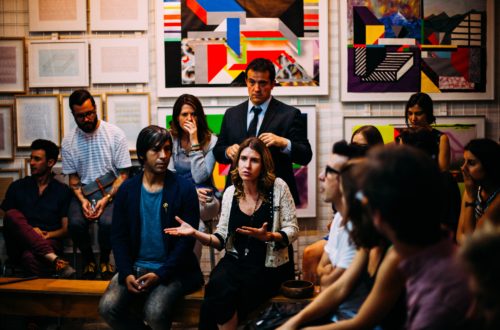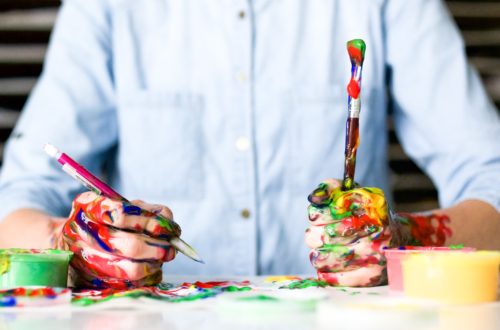What Mindfulness Is In a Classroom: Must-Have Activities.

When I think of what mindfulness is in a classroom, I think of the place where students are driven by their own goals and interests, are in charge of the creative space, believe and know they can tackle difficult things, support each other, and grow physically and emotionally.
- Mindfulness is that classroom vibe where a teacher facilitates, not dictates.
- Mindfulness is taking mental pauses and breaks for a teacher and students when the day gets tough.
- Mindfulness is being aware of the limitations and the possibilities for students and a teacher.
- Mindfulness is challenging the limitations and attempting bigger things following small, consistent steps.
In fact, it’s pretty hard to capture the proper interpretation of mindfulness because anyone has their path to discover what mindfulness is and how to use it in life to grow above the limitations and fears.
I once was very skeptical about mindfulness and thought that a mindful classroom is not available to everyone. I was also unsure about whether children can get it, can understand it, and can adopt it into their lives.
Luckily, I was wrong.
As a mom of a child with anxiety, I have come to understand that with consistent teaching, explanation, and a personal example from a parent, a little child can become great at recognizing emotions, talking about emotions, applying tools of managing emotions, and thinking about how emotions impact his/her life.
Often flabbergasted by my child’s ability to talk about emotions, I get convinced daily that talking about feelings and teaching what mindfulness is to a child is a must-do for any parent.
“Mom, you hurt my feelings today…”
“Mom, just breathe and squeeze the pillow.”
“Mom, I’m not comfortable talking to my new friend yet, but I will think about that.”
“Mom, I was not honest today…”
These are some of the words my 6-year-old child has behind her belt when she talks to me about how she feels. She can also describe the “size” of her emotions and pinpoint the reason.
I think this is the skill I had lacked for the most chunk of my life until I started learning about what mindfulness is and how it can save me from stress, overwhelm, self-blaming, and unhappiness.
Bringing mindfulness into my family’s life was an important decision. As a 2nd grade teacher, I see the need to teach kids about self-awareness and self-management. Integrating mindfulness practices into a daily routine in a classroom can transform how students feel, behave, and support them in reaching their best potential.
So, what is mindfulness in a classroom? Well, I guess any teacher will give you a different answer and offer his/her list of tools to promote mindfulness.
It might not be obvious at first, but the truth is it does not matter because, among hundreds of ideas about how to bring mindfulness to a classroom, one can choose mindful tools and practices that best match their classroom atmosphere.
In this post, I will give you some “skepticism-busting” suggestions and tools about how to infuse mindfulness into your classroom.

Mindfulness is Teaching About Fixed VS. Growth Mindset.
The fixed mindset effect is strong, and students can be affected by it even in early grades.
What is a growth mindset? In a nutshell, the growth mindset is a belief that your abilities can change and develop with hard work and practice.
Why is teaching growth mindset explicitly so important? It’s essential because kids will have doubts, fears; would want to give up at times because of academic difficulties or even boring lessons. The reason might be they have not enough support or examples at home to help them shed personal self-doubt and grow their potential.
How can you teach a fixed vs. growth mindset?
- Teach students what growth and fixed mindset look like,
- Help students see the difference between fixed and growth mindsets and the language associated with them,
- Ask students to think about what they can do when they feel like giving up. Engage students in a discussion about situations that make them feel like giving up,

- Engage students in conversations with a partner about different ways to help them persevere in difficult situations,
- Let students see that mistakes are part of learning,
- Engage students in a discussion about how other people look at difficulties and mistakes.

Some excellent videos that can be appropriate for kids to see on the topic are here:
- What is a growth mindset? – from Mindset Kit.
- Growth mindset for students – from ClassDojo on YouTube.
- Developing a growth mindset – from ClickView on YouTube.
Explore these resources for:
- Fixed vs. Growth Mindset
- Stress management
- Student’s strengths
- Kindness challenge
- Activities for emotions and behavior
- Discussing emotions and behavior
- Emotions and behavior toolkit

Mindfulness is Teaching About Fears and How To Manage Fears and Bad Days.
We all have fears. Students in an elementary classroom may not yet have the vocabulary to talk about what bothers them. Teaching students about fears and bad days will expose them to the ideas of mindfulness and a growth mindset.
- engage students in a conversation about what makes them upset and what their biggest fears are,
- teach students that it’s ok to have a bad day and that they need to develop positive thinking,

- teach students vocabulary to express their stress/anxiousness in a better way,
- engage students in a discussion about what to do when worry takes over,

- arrange a group discussion about famous sayings/ proverbs that teach a valuable lesson,
- ask students to develop their coping toolkit,
- offer opportunities to write and express what they feel.

Great videos for kids on the topic:
- Kids talk …Anxiety.
- Managing worry and anxiety for kids.
- 5 things you can control.
- Even superheroes have bad days by Shelly Becker.
Explore done-for-you “Stress Management” Journal.
Mindfulness is Teaching How to Recognize and Manage Feelings/ Emotions.
A considerable part of teaching about mindfulness and what it looks like in real life is teaching students about feelings, emotions, and how emotions impact behavior.
When students can recognize their feelings and emotions, they can manage them better and do more things that invoke positive feelings.
Remember, mindfulness is attention to a present-moment experience and accepting and managing negative emotions constructively.
There are many things you can do to start a conversation about feelings and how they affect behavior:
- introduce what emotions are there and the science behind emotions (why emotions happen, what triggers emotions),
- allow students to investigate each emotion and find out physical and behavioral cues for each emotion (anger, sadness, happiness, disgust, fear, surprise),
- enable students to draw and write about feelings as well as reflect on emotions through questions.
Explore done-for-you “Activities for emotions and behavior“.
If your students are ready for a more serious conversation about emotions, here is what you can do:
- engage students in further discussion about what emotions look like and feel like,
- arrange students in groups to talk about how to manage emotions and why emotions happen in the first place,
- give students questions to talk to each other and relate emotions to some situations in their lives,
- create opportunities for students to be creative and develop their emotional toolkits that can be displayed in a classroom quiet corner.
Explore done-for-you “Discussing emotions and behavior” and “Emotions and behavior toolkit“.
Mindfulness is Encouraging Students to Recognize Their Strengths.
Self-awareness is an essential element of emotional intelligence every child needs to develop.
Apart from learning about feelings, emotions, and how emotions impact behavior, student needs to recognize their strengths because it will help them become more confident and become more successful in academics. Besides, learning about their strengths, students will create strong bonds with classmates and build strong relationships.

- teach students what strength is and give students examples of strengths,
- talk about a historical figure or a character in a book that have particular strengths; give students discussion question to bring their attention to how strengths shape a person’s personality and life experience,

- prompt students to think about their strengths and explain why they believe they have a specific strength,
- arrange group discussion that will allow students to think about their strengths,
- ask students to interview their parents and ask them questions to learn more about strengths,
- give students time to self-reflect and present their strengths in from of the class.

Explore done-for-you resources ” Student’s strengths.”
Mindfulness is Showing Students How to Take Care of Others and How To Be Kind to the People Around.
Create opportunities in a classroom to show kindness to everyone around. Arrange a classroom challenge where students work as a class monthly to be kind and show kindness to everyone in a school.

How about this fun challenge where each student does one kindness challenge every day for 30 days? The progress is recorded on a challenge sheet. Students can work on a 30-day kindness challenge independently or in pairs.
Explore done-for-you resource “Kindness challenge.”
If you are determined to make the social-emotional learning part of your classroom, watch FREE “Mindful Teacher” workshop.
I will show you the easiest and the fastest ways to integrate mindfulness in your teaching WITHOUT having to follow another curriculum.
This workshop will give you ideas and tools you can put into your toolkit to start designing your own mindful classroom!
STAY CONNECTED:
- To explore the social-emotional learning / mindfulness activities, worksheets, and other resources for a classroom, stop by the Mindful Message Shop.
- Join me on INSTAGRAM.
Don’t forget to stay in touch!
Talk to you later!
Yanina.















